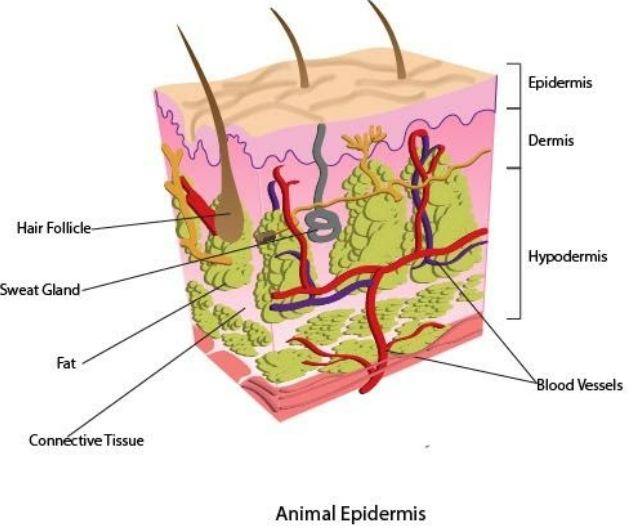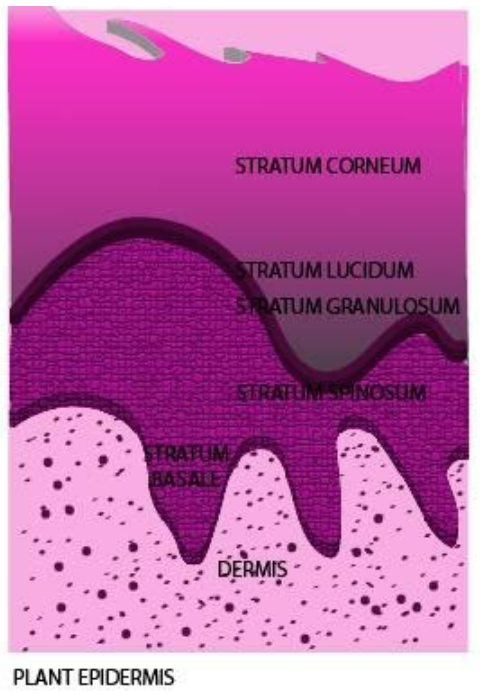
What does the epidermis do?
Answer
426.9k+ views
Hint: The animal skin has three main layers, namely, hypodermis, dermis and epidermis. The epidermis is the outermost layer of the skin. It is thin and durable and acts as a protective barrier to the living body. In plants, the epidermis is a single layer of cells that covers it’s the leaves, flowers, roots and stems.
Complete answer:
The epidermis layer in an animal body acts as a barrier to infection from environmental pathogens. It also regulates the amount of water released from the body into the atmosphere through transepidermal water loss. The epidermis consists of multiple layers of flattened cells. These layers lie on a base layer called stratum basale, composed of columnar cells arranged perpendicularly. Above the base layer contains stratum spinosum, stratum granulosum, stratum lucidum and stratum corneum in that same order. The epidermis protects the body against microbial pathogens, oxidant stress (UV light), chemical compounds and provides mechanical resistance to minor injuries. Most of this barrier role is played by the stratum corneum.
Physical barrier: Epidermal keratinocytes are tightly linked by cell–cell junctions, giving the epidermis its mechanical strength.
Chemical barrier: Highly organized lipids, acids, hydrolytic enzymes and antimicrobial peptides inhibit the passage of external chemicals and pathogens into the body.
Immunologically active barrier: The humoral and cellular constituents of the immune system found in the epidermis actively combat infection.
Water content of the stratum corneum drops towards the surface, creating hostile conditions for the growth of pathogenic microorganisms. An acidic pH (around 5.0) also makes the epidermis hostile to many micro-organic pathogens. Non-pathogenic microorganisms on the surface of the epidermis defend against pathogens by competing for food, limiting its availability and producing chemical secretions that inhibit the growth of pathogenic micro-biota. Lipids arranged through a gradient in an organized manner between the cells of the stratum corneum form a barrier to transepidermal water loss. This is how the skin remains hydrated. The number of melanosomes in the
keratinocytes increase with exposure to UV radiation while their distribution remains largely unaffected, giving the skin its colour.
In plants, the epidermis protects against water loss, regulates gas exchange, secretes metabolic compounds, (especially in roots) absorbs water and mineral nutrients. The epidermis of most leaves show dorsoventral anatomy: the upper (adaxial) and lower (abaxial) surfaces have different construction and serve different functions. Woody stems and some other stem structures such as potato tubers produce a secondary covering called periderm that re- places the epidermis as the protective covering. Various modified epidermal cells in plants regulate transpiration, increase water absorption and secrete substances. The leaf and stem epidermis is covered with pores called stomata. Typically, the stomata are numerous over the abaxial (lower) epidermis of the leaf than the (adaxial) upper epidermis.
Note:
The epidermis in the animal body primarily consists of 90 percent keratinocytes. The constituents being melanocytes, Langerhans cells, Merkel cells and inflammatory cells. The plant epidermis consists of three main cell types: pavement cells, guard cells and their subsidiary cells that surround the stomata and trichomes, otherwise known as leaf hairs. The epidermis of petals also form a variation of trichomes called conical cells.


Complete answer:
The epidermis layer in an animal body acts as a barrier to infection from environmental pathogens. It also regulates the amount of water released from the body into the atmosphere through transepidermal water loss. The epidermis consists of multiple layers of flattened cells. These layers lie on a base layer called stratum basale, composed of columnar cells arranged perpendicularly. Above the base layer contains stratum spinosum, stratum granulosum, stratum lucidum and stratum corneum in that same order. The epidermis protects the body against microbial pathogens, oxidant stress (UV light), chemical compounds and provides mechanical resistance to minor injuries. Most of this barrier role is played by the stratum corneum.
Physical barrier: Epidermal keratinocytes are tightly linked by cell–cell junctions, giving the epidermis its mechanical strength.
Chemical barrier: Highly organized lipids, acids, hydrolytic enzymes and antimicrobial peptides inhibit the passage of external chemicals and pathogens into the body.
Immunologically active barrier: The humoral and cellular constituents of the immune system found in the epidermis actively combat infection.
Water content of the stratum corneum drops towards the surface, creating hostile conditions for the growth of pathogenic microorganisms. An acidic pH (around 5.0) also makes the epidermis hostile to many micro-organic pathogens. Non-pathogenic microorganisms on the surface of the epidermis defend against pathogens by competing for food, limiting its availability and producing chemical secretions that inhibit the growth of pathogenic micro-biota. Lipids arranged through a gradient in an organized manner between the cells of the stratum corneum form a barrier to transepidermal water loss. This is how the skin remains hydrated. The number of melanosomes in the
keratinocytes increase with exposure to UV radiation while their distribution remains largely unaffected, giving the skin its colour.
In plants, the epidermis protects against water loss, regulates gas exchange, secretes metabolic compounds, (especially in roots) absorbs water and mineral nutrients. The epidermis of most leaves show dorsoventral anatomy: the upper (adaxial) and lower (abaxial) surfaces have different construction and serve different functions. Woody stems and some other stem structures such as potato tubers produce a secondary covering called periderm that re- places the epidermis as the protective covering. Various modified epidermal cells in plants regulate transpiration, increase water absorption and secrete substances. The leaf and stem epidermis is covered with pores called stomata. Typically, the stomata are numerous over the abaxial (lower) epidermis of the leaf than the (adaxial) upper epidermis.
Note:
The epidermis in the animal body primarily consists of 90 percent keratinocytes. The constituents being melanocytes, Langerhans cells, Merkel cells and inflammatory cells. The plant epidermis consists of three main cell types: pavement cells, guard cells and their subsidiary cells that surround the stomata and trichomes, otherwise known as leaf hairs. The epidermis of petals also form a variation of trichomes called conical cells.


Recently Updated Pages
Master Class 10 Computer Science: Engaging Questions & Answers for Success

Master Class 10 Maths: Engaging Questions & Answers for Success

Master Class 10 English: Engaging Questions & Answers for Success

Master Class 10 General Knowledge: Engaging Questions & Answers for Success

Master Class 10 Science: Engaging Questions & Answers for Success

Master Class 10 Social Science: Engaging Questions & Answers for Success

Trending doubts
State and prove Bernoullis theorem class 11 physics CBSE

Raindrops are spherical because of A Gravitational class 11 physics CBSE

What are Quantum numbers Explain the quantum number class 11 chemistry CBSE

Write the differences between monocot plants and dicot class 11 biology CBSE

Why is steel more elastic than rubber class 11 physics CBSE

Explain why a There is no atmosphere on the moon b class 11 physics CBSE




